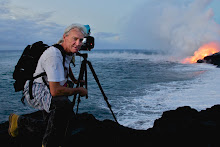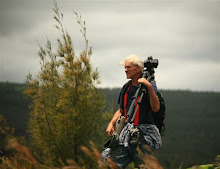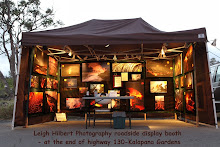
Last night the crescent moon hung with Venus in the evening sky as seen from highway 130 where visitors walk to the viewing area.
Fact sheet:
Hawaiian Meaning
The Hawaiian name "Kīlauea" means "spewing" or "much spreading," apparently in reference to the lava flows that it erupts.
Most Recent Eruption
Continuous since January 3, 1983
Number of Historical Eruptions
61, not counting the continuous lava-lake activity in Halema`uma`u crater
Summit Caldera
The caldera itself has no Hawaiian name other than Kīlauea but houses the famous crater, Halema`uma`u; "hale" is a house, "ma`uma`u" a type of fern. Kamapua`a, a jilted suitor of Pele, is said to have built a house of ferns over Halema`uma`u to keep Pele from escaping her home and causing eruptions. The ploy failed.
· Dimension: 6 x 6 km (outermost faults), 3 x 5 km (main depression)
· Depth: 165 m deep
· Age: probably several incremental collapses 500-210 years ago
Oldest Dated Rocks
23,000 years old
Estimated Age of Earliest Subaerial Eruptions
50,000-100,000 years
Estimated Age of First Eruption of Kīlauea
300,000-600,000 years before present
Hawaiian Volcano Stage
Shield-forming stage
Copied from USGS page here
----------------------------------------------------------------------------------------
I am re-posting yesterday’s blog here since little has changed in 24 hours:
Halema’uma’u Crater still glowing brightly ~ Lava flows hot from mountain to sea

US Geological Service (USGS) at Hawaii Volcanoes National Park Observatory (HVO) has posted this excellent aerial photo over crater (above) on their images page. On that page they also have photos and captions about the Pu`u O`o crater cam they lost when a piece of the crater sloughed off a few days ago.
 (Click on it for a larger view size in a new window)
(Click on it for a larger view size in a new window)The aerial photo is from the April 28th, 2010 USGS image site, and surface lava has advanced further in many areas since, as indicated on my drawings and notes.
 Halema’uma’u crater as seen after dark from the balcony of the Jaggar Museum
Halema’uma’u crater as seen after dark from the balcony of the Jaggar MuseumActive lava viewing prospects:
1) The Halema’uma’u crater has been degassing sulfur dioxide fumes by day and glowing strongly at times after dark from lava deep within the craters pit vent. Great views are from the Jaggar Museum within the Hawaii Volcanoes National Park, and the park is open to the public 24 hours a day.
2) Coastal viewing:
Highway 130 at Kalapana Gardens area -- Between the hours of 2:00 PM and 8:00 PM - park and walk one mile to the end of newly lava covered (May 5th) road; viewing is allowed until about 9:00 PM. Along the walk out and back the steam plume from the distant ocean entry lava can be seen and after dark it glows orange-red; long lines of degassing lava fumes coming down the hillsides by day –distant red lava orbs lined-up by night; at roads end the still-warm lava on the road can be felt and is still radiating hotter close by but beyond public access; occasional yellow flare-ups are witnessed in the distance as lava torches trees and vegetation further into the active flow field. Offered at the parking area only: security personnel, vendors, water and port-o-potties available; at roads end there are barricades, port-o-potties and security personnel.
USGS lava flow map gives a good indication of the active lava zones:

~~~~~~~~~~~~~~~~~~~~~~~~~~~~~~~~~~~~~~~~~~~~~~~~~~~~~~~~~~~~~~~~
Further information, links and warnings:
Active pahoehoe breakouts continue along with swelling of the hot flow fields at many locations of the April-May surface flow. The coastal entry points are still emptying a lot of lava into the sea as new deltas area being rapidly built. The entire length of the ocean entry and all land adjacent to it inland is quickly becoming unstable and should be kept well aware of from now on:
HAZARD ALERT: The lava delta and adjacent areas both inland and out to sea are some of the most hazardous areas on the flow field. Frequent delta/bench collapses give little warning, can produce hot rock falls out to 400 m (quarter mile) inland and in the adjacent ocean, and can produce large local waves and scalding water. The steam plume produced by lava entering the ocean contains fine lava fragments and an assortment of acid droplets that can be harmful to your health. The rapidly changing conditions near the ocean entry have been responsible for many injuries and a few deaths.
Below is the timeline links to my posts for this April-May flow:
You can watch the May 5th feature Hawaii-News-Now story of the lava coming onto the end of highway 130 by clicking this link here
Click on this link for a complete blog summary of this entire April, 2010 surface flow of lava; from mountain to sea: (scroll to the bottom and read each post running up for a chronological timeline)
And my most recent days postings for May, 2010
I will keep this as my main posting update layout in the coming days, adding new headings and images as lava events warrant.










Hi! I'm visiting my mom who lives here on the island for 2 weeks. I'm starting my second week here and we went out to the lava viewing site today. We got there around 6pm. The guards were out and wouldn't let anyone go any further than where the road ended. I didn't see much today. I've been reading your site everyday since I've gotten here. I'm hoping that something amazing will happen while I'm here. I don't really have a lot of money to spend on the boat tour. But I'm tempted. Anyways I just wanted to thank you for the site. It's my favorite for updates on the lave flow :)
ReplyDelete